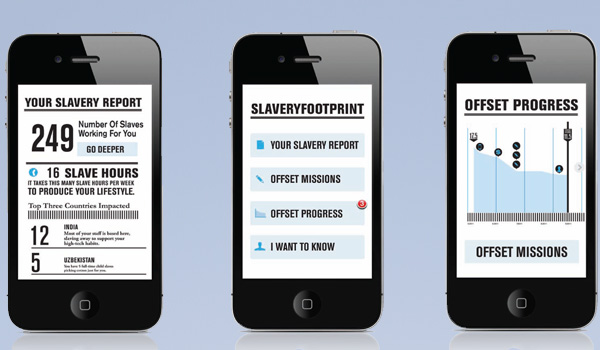Slavery Footprint: Calculating How Many Forced Labourers Work For You
Cue the bright-eyed, pigtailed offspring of ethical consumerism and social media, Slavery Footprint.
It’s nothing new to reference the explosion of social media across our cultural landscape, how it mediates our fumbling navigation through the murky and glorious waters of the World Wide Web, nor how its various forms facilitate and foster ever-expanding networks of communication, knowledge and connection globally. Rather than contracting our cyber presence to the corners of our computer screens, sites such as GetUp! and Twitter have become the go-to tools of a dynamic, interwoven and international citizenry in their various en-masse calls for change to governments, institutions and laws (think of the Arab Spring, or the current ‘Occupy Wall Street’ movement).
A concurrent trend of the Noughties has been the popularisation of ethical consumerism. No longer the exclusive domain of hippies or hipsters, the growth of demand for organic food, fairtrade goods, farmers markets and the like reveal a genuine awakening regarding the production of goods as well as a desire to align one's consumerism with one's values.
Cue the bright-eyed, pigtailed offspring of these two trends, Slavery Footprint.
A new app developed by Justin Dillon, Slavery Footprint aims to show you how many ‘slaves’ your consumption entails via the supply chain, which, the website informs, now enslaves more people than at any time in human history. The application isn’t designed as a guilt trip or a disincentive to buying, but rather is geared towards heightening awareness as an avenue for inciting change – change through you, and your choices. And not just a change in the brands you buy – the app doesn’t offer ‘alternative, cruelty-free’ options so as to avoid the emergence of expensive, ‘ethical’ brands only economically accessible to certain demographics – but rather a change in the entire mentality towards consumption and, hopefully, along with it, the enterprise of slave labour that sustains it.
Says Ambassador Luis CdeBaca of the U.S. State Department's Office to Monitor and Combat Trafficking in Persons, who helped develop the app, “You’re going to be touched by slavery no matter what, and I think that’s actually a liberating thing. We can no longer say this is someone else’s problem….” Overwhelmingly, the ethos of the app is empowerment, and apparently Dillon has struck an untapped reservoir of empowerment-hungry shoppers.
On a recent trip to Melbourne I happened across a piece of paper stuck to a graffitied wall in an alleyway that asked “Is our empathy on the rise?” After ponderous deliberation, I wrote “Maybe, but I think we can do better”. And with the aid of innovations such as Slavery Footprint, perhaps we can, after all.








